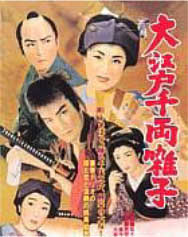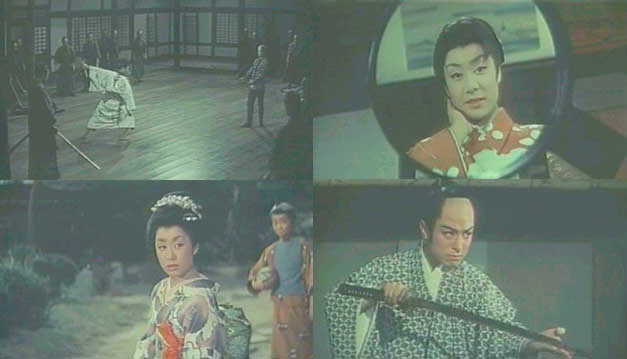The Secret of the Golden
Spell

Director: Sadatsuga Matsuda
Year: 1962
Production Company: Toei
Running Time: 99 minutes
This is an enjoyable continuation of the Otomo Ryutaro series of Tange
Sazen films. The only date I could find for it was 1962 which places it somewhere
towards the end of the series that Otomo did. This seems a bit odd because
it is yet another retelling of the original story in which the fortunes of
the Yagyu clan rests on finding the whereabouts of their family treasure.
One might have thought that this story would have come fairly early in the
series, but perhaps by 1962 they felt it was a needed chapter in their series.
Much of the story is a rehash of other versions, but enough is tweaked to
still make it interesting and in truth much of the pleasure of the film is
the energetic performance of Otomo, the genial relations of the characters
and the occasional frantic slashing of swords. This film was also my introduction
to one of Japan’s most popular actresses at the time – Misora Hibari – and
she is a delight.

A senior advisor has an audience with the Shogun and tells him that it has
come to his attention that the Yagyu family has a huge amount of money that
was secreted away by their ancestors as a war fund. The Shogun sees this
as a potential risk at some point and the government policy is to make the
clans as dependent on the central government as possible and to limit any
risk of rebellion. The advisor suggests that a clan needs to be assigned
to repair the Nikko Shrine the following year and that the Yagyu’s should
receive this “honor”. This is an enormous undertaking and would bankrupt
any small clan like the Yagyu’s and so this should force them to locate this
hidden treasure and use it for the shrine – and thus eliminate a potential
danger. A goldfish lottery in which the clan that gets the dead goldfish
is responsible for the Nikko repairs is fixed and the Yagyu family finds
to their horror that they have been assigned this duty.

In the meantime, the son of the Yagyu clan, Genzaburo (Okawa Hashizo) has
been told that he must marry the daughter of the fencing owner of one of
Edo’s most prestigious schools. He isn’t particularly happy with this and
so goes to the school on his own and finds work as a gardener where he can
scope out the place and see what the daughter, Hagino, is made of. In a matter
of minutes he is head over heels with her – “spoony” as they say and this
is not difficult to believe as Hagino is played by Misora Hibari. She was
perhaps Japan’s most popular singers/actress’s of the period and sings three
songs in this film. Within the fencing school a conspiracy is taking place
– Hagino’s father is on his deathbed and the number two instructor wants
to take over the school when he passes away – but if Hagino is married this
will pass to her husband. So he hires Yokichi (brother of Ofuji) to steal
the wedding gift – the Koke-zaru jar – to force a postponement of the wedding
in hopes that the old man will die.

Inside the jar of course are the instructions on where to find the family
treasure and it soon comes into the hands of Sazen and everyone is after
it and being the cantankerous sort he just wants to cause trouble. He ends
up becoming good friends with Genzaburo and Hagino and when the bad guys
make the mistake of capturing and holding hostage Hagino and Chobiyasu (Sazen’s
adopted child), there is hell to pay as Sazen tells his sword that it will
be getting more than a taste of blood. The film has the usual bantering between
Sazen and Ofuji (again played by Sakuramachi Hiroko), his soft spot for Chobiyasu
(also reprised by the same actor – as is Yokichi) and it is this warmth that
the film surrounds itself with that makes this series as easy to digest as
it is.

My rating for this film: 7.0





